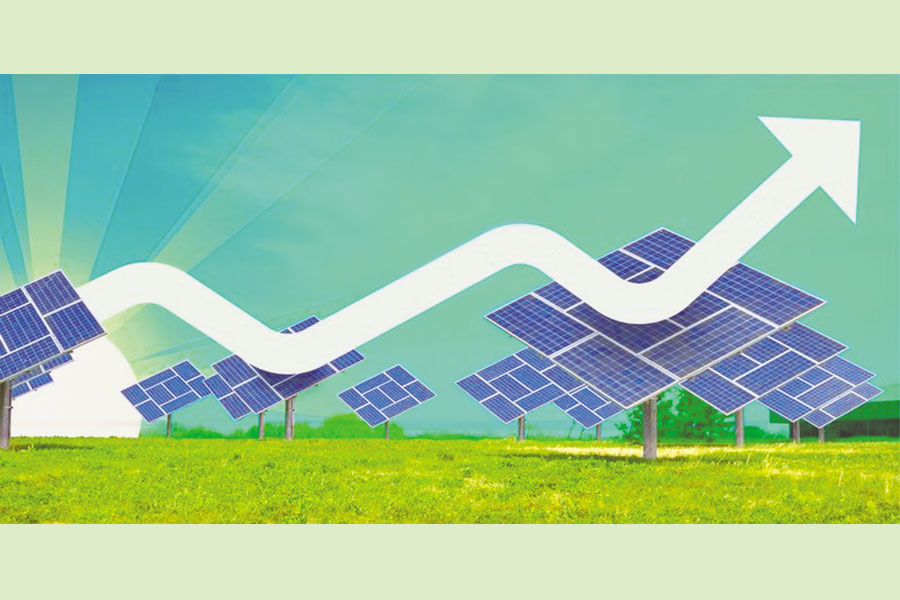
Published :
Updated :

As of July, 2025, Bangladesh's installed solar energy capacity reached 1,307.15 megawatts (MW), up from 949.65 MW in June 2023-a 38 per cent increase in just over two years. While this surge underlines the growing momentum in the country's transition to clean energy, significant financial, technical, and policy challenges threaten to slow the pace of expansion.
Despite robust growth in solar panel installations-ranging from utility-scale solar parks and mini-grids to rooftop and irrigation systems-the financing ecosystem for renewable energy remains underdeveloped. High capital investment requirements, complex regulatory procedures, and inadequate technological expertise are among the major barriers deterring banks and private investors from scaling up their involvement in large renewable projects in the areas like solar, wind, hydro, and biomass power.
After more than 16 years, the government approved a new version of the Renewable Energy Policy in June 2025, enhancing its ambition to harness 20 per cent and 30 per cent renewable energy by 2030 and 2040, respectively, creating optimism among stakeholders, Shafiqul Alam, Lead Energy Analyst for Bangladesh, Institute for Energy Economics and Financial Analysis (IEEFA), told the FE.
However, Bangladesh's renewable energy sector is crawling ahead when most countries are rapidly expanding use of solar, wind and other renewable energy sources. Despite the falling trend of renewable energy costs, Bangladesh had its own set of problems, he said.
The suspension of utility-scale projects and tepid interest of investors in the latest round of tenders for utility-scale projects meant that the country had a barren project pipeline apart from a few under-construction projects, Shafiqul said.
The suspension of utility-scale projects affected investors' confidence. Further, the absence of the 'implementation agreement' was unlikely to attract sufficient bidders. It pointed to a barren period of private-sector-led new utility-scale projects in the next one or two years, he stated.
A recent IEEFA report estimates that Bangladesh will require between US$933 million and US$980 million annually until 2030 to meet the government's renewable energy goal of sourcing 20 per cent of electricity from renewables by that year. This figure will rise to range between US$1.37 billion and US$1.46 billion per year from 2031 to 2040 to meet the 30 per cent target. Given these requirements, public finance alone is unlikely to suffice, necessitating substantial private-sector participation.
Yet policy inconsistency remains a significant hurdle. The suspension of 31 utility-scale projects that were approved through a non-competitive process under the previous government has shaken investor confidence. The abrupt transition to competitive bidding, without a clear roadmap or revenue assurance mechanism, has increased project risks and introduced contractual uncertainty.
According to stakeholders, another critical challenge is access to affordable finance. High interest rates, short loan tenors, and stringent lending norms for green projects make it difficult for developers to secure long-term capital. The central bank's green fund could be more effective, if it moves toward a pre-finance model to streamline disbursement and minimize bureaucratic delays.
Local financing barriers are compounded by external headwinds. The country's low sovereign credit rating-downgraded to B2 by Moody's in late 2024-further discourages foreign investment by raising the cost of international borrowing. Moreover, a weak bond market and limited access to currency hedging instruments constrain long-term funding options for renewable ventures.
Technology also plays a defining role in shaping the solar energy landscape. Over the past 15 years, low-cost Chinese solar components have dominated Bangladesh's market, driven by their affordability and global supply chain strength. According to Infrastructure Development Company Ltd (IDCOL), Chinese manufacturers now command over 60 per cent of the solar home system (SHS) market in Bangladesh, followed by Canada (20 per cent), Germany (15 per cent), and India (5 per cent).
Chinese firms like Longi Solar, JA Solar, Huawei, and Sungrow Power Supply have supplied critical components-PV panels, inverters, and cables-to nearly all of the country's ten operational solar parks. Local stakeholders note that the price per watt of Chinese panels is 30-35 per cent lower than European counterparts, making them the preferred choice for both public and private developers.
Notable examples include Teesta Solar Ltd, which launched the country's largest solar plant (200 MW) in Gaibandha, using panels from Longi and inverters from Sungrow. Energon Renewables, Intraco Solar, and Joules Power have also relied heavily on Chinese tech to build their respective utility-scale projects.
The 200-megawatt (MW) plant, spanning 650 acres on the banks of Teesta River in Gaibandha's Sundarganj upazila, was officially inaugurated on August 2, 2023. It began commercial operation in January 2023.
Mr Alam also said the much-discussed land crisis could be addressed with proper resource mapping and earmarking available land for utility-scale solar projects. Special economic zones could also accommodate a significant amount of new renewable energy capacity.
"The rooftop solar segment with significant potential is still underexplored. While the new rooftop solar programme launched with the target of achieving 3,000MW by December 2025 is a welcome move and could provide the much-needed boost to it. Proper monitoring, quality control and the presence of sufficient resources (both financial and human resources) will be central to its success", he said.
This is the time for project implementation as rapidly as possible while ensuring quality to achieve the renewable energy targets for the country's energy security. However, contrary to any belief that only targets would drive renewable energy growth, a conducive ecosystem was essential in the country, he added.
sajibur@gmail.com


 For all latest news, follow The Financial Express Google News channel.
For all latest news, follow The Financial Express Google News channel.